| Image search results - "each" |
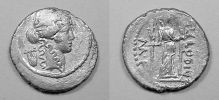
Denarius - 42 BC.
P. CLODIVS M.f. - Gens Claudia
Obv.: Laureate head of Apollo right, lyre behind
Rev.: Diana "Lucifera" standing facing, with bow and quiver over shoulder, holding lighted torch in each hand; P CLODIVS right, M F on left.
Gs. 3,3 mm. 19x18
Craw. 494/23, Sear RCV 492
Maxentius
|
|

Denarius - 49 B.C.
L CORNELIVS LENTVLVS & C CLAVDIVS MARCELLVS - Gens Cornelia.
Obv.: Facing head of Medusa in center of triskeles, ear of corn between each leg
Rev.: Jupiter standing right with thunderbolt & eagle. LENT MAR (NT & MAR in monogram) left, COS right.
Gs. 3,5 mm. 18,4
Craw. 445/1b, Sear RCV 414.
Maxentius
|
|
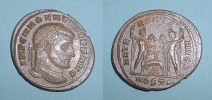
MAXENTIVS - Follis - Ostia mint - 309 AD
Obv.: IMP C MAXENTIVS P F AVG, laureate head right
Rev.: AETERNITAS AVG N, Castor and Pollux standing facing each other, each leaning on sceptre and holding bridled horse. In ex. MOSTA
Gs. 6,7 mm. 27,5
Cohen 10Maxentius
|
|

Denarius - 89 BC - Mint of Rome
L. TITVRIVS SABINVS - Gens Tituria
Obv.: Head of Titus Tatius right; SABIN behind, palm before
Rev.: Two Roman soldiers, each carrying a woman; L. TITVRI in exergue.
Gs. 4 mm. 17x18,9
Cr344/1b, Sear RCV 249, Grueber 2325.
Maxentius
|
|

Denarius - 109/108 BC.
L. MEMMIVS - Gens Memmia
Obv.: Young male head (Apollo?) right, wearing oak-wreath; before, mark of value
Rev.: Dioscuri standing facing between their horses, each holding spear; L MEMMI in ex.
Gs. 3,9 mm. 18,96
Crawf. 304/1, Sear RCV 181, Grueber II 643
Maxentius
|
|

Bronze AE 3, RIC 88, VF, 2.24g, 18.4mm, 180o, Antioch mint, 330 - 335 A.D.; obverse FL IVL CONSTANTIVS NOB C, laureate and cuirassed bust right; reverse GLOR-IA EXERC-ITVS, two soldiers, each holding spear and shield on ground, flanking two standards, SMANH in exareich
|
|

Antioch RIC VIII 37 Constantine the Great AE3.
DV CONSTANTI-NVS PT AVGG, veiled head right /
No legend, emperor veiled to right in quadriga, the
hand of God reaches down to him, star in top centre.
Mintmark: SMANH. Coin #150
cars100
|
|

Macrinus Denarius
20 mm 3.05 gm
O: IMP C M OPEL SEV MACRINVS AVG
Bust draped and cuirassed right.
R: FIDES MILITVM PRINC IVVENTVTI
Fides standing front, head right, right foot on helmet, holding standard in each hand.Koffy
|
|

FAUSTINA II (wife of M. Aurelius) - As - 160 AD - Rome mint
Obv: FAVSTINA AVGVSTA, Draped bust right
Rev: FECVND AVGVSTAE S C, Fecunditas standing left, one child on each arm, two at her feet
Gms 9,2 mm 27,3
RIC 1636 Cohen 97Maxentius
|
|

Romanus III, Class B Follis, Constantinople, 1028-1034 AD
IC to left, XC to right
Christ, bust facing, square in each limb of nimbus cross,
holding book of gospels
IS-XS / BAS-ILE / BAS-ILE
cross with dots at the ends, on three steps
SB 1823
11.8g / 27mm
Antonivs Protti
|
|

Preparing to trim down my collection to one portait of each Roman family member that I can find this is the third tray to the end of the third century.mauseus
|
|

Preparing to trim down my collection to one portait of each Roman family member that I can find this is the second tray, the first part of the third century. Compiled this tray then noticed that I'd forgotten to put in Trajan Decius (doh!).mauseus
|
|

Here is an example of a cabinet showing three different available styles of trays for storage. At the top is a standard round recess type tray....very traditional.
In the middle is an open format tray for displaying items "free form", or for items of unusual sizes/shapes such as large medals, military decorations or pocket watches.
On the bottom is a new offering; a drawer for slabs. Each drawer can hold 30 slabs from any of the three major slabbing firms; PCGS, NCG, or ANACS. Other commercial, or "DIY" slabs should also fit, provided they are no larger than any from the "big three" firms.
www.CabinetsByCraig.netcmcdon0923
|
|

Heraclius, with Heraclius Constantine. 610-641. Æ Follis (29mm, 8.63 g, 6h). Cyzicus mint, 1st officina. Dated RY 3 (AD 612/3). Crowned and draped figures of Heraclius and Heraclius Constantine standing facing, each holding globus cruciger; cross above / Large M; cross above, A/N/N/O III (date) across fields; A//KYZ. DOC 175a; MIB 185; SB 840Quant.Geek
|
|

AE 3; 20mm, struck c. 319 AD
Con/ VF; brown patina.
Obv/ LICINIVS IVN NOB CAES; laur., dr. and cuir. bust r.
Rev/ VICTORIAE LAETAE PRINC PERP; two Victories stg. facing each other, together holding a shield inscribed VOT PR on an altar inscribed with the letter S. Gamma SIS pellet in exergue.
Ref/ RIC VII 70 = Rare 3Mayadigger
|
|

A 15 tray cabinet with extra wide (15") trays lined with red felt. Each tray can hold an item up to 1/2 inch thick...perfect for medals or other over-sized items.
CabinetsByCraig.netcmcdon0923
|
|

Heraclius & Heraclius Constantine overstruck on Phocas & Leontia . 610-641 / 602-610. Æ follis (26.89 mm, 8.78 g, 6 h). Host coin, Theopolis (Antioch) mint, 602-610 / after 610. overstrike, Thessalonica mint. Overstrike: fragmentary, d N hЄRA[CLIЧS PP AVG] �Host coin, also fragmentary, [O N FOCA] NЄ PЄ [AV] , Overstrike: Heraclius (on left, and Heraclius constantine, barely visible on right) standing facing, each holding globus cruciger, cross between their heads �Host coin: Phocas on left and Leontia standing facing; Emperor holds globus cruciger, Empress holds cruciform scepter; cross between their heads / Overstrike, large M between A / N / N / O and date (not struck-up), cross above, B below, ΘЄC in exergue�Host coin, large m between [A / N /] N / O and date (unclear) cross above, ThЄЧP' in exergue. Host coin, Cf. SBCV 671; Overstrike, Cf. SBCV 824. VF for type, dark green patina on devices, lighter encrustation on fields - overstrike at ~ 90º ccw. ��
multiply struck: host coin is Phocas & Leontia from Antioch, SBCV 671 or similar �overstrike, at ~ 90º ccw, is Heraclius from Thessalonica Quant.Geek
|
|

Southern Gaul, Volcae-Tectosages. 1st century B.C. AR drachm (12 mm, 2.39 g). Head left with wild hair and Negroid features / Cross with one ring and three pellets in angles, crescents enclosing each quadrant. LT 2986Quant.Geek
|
|

Northwest Gaul, Carnutes. Ca. 100-52 B.C. Æ (16 mm, 3.12 g, 9 h). Head right / Two eagles flying right; in field, pentagram and cross with pellet in each quarter; serpent to right. Depeyrot 25; Delestrée & Tache 2582Quant.Geek
|
|

HENRY VI
Henry VI was King of England from 1422 to 1461 and again from 1470 to 1471. The only child of Henry V, he succeeded to the English throne at the age of nine months when his father died.
This was during the period of the long-running Hundred Years' War (1337 - 1453) and Henry is the only English monarch to also have been crowned King of France (as Henri II), in 1431. During his early reign several people were ruling for him and by the time Henry was declared fit to rule in 1437 he found his realm in a difficult position, faced with setbacks in France and divisions among the nobility at home. Henry is described as timid, shy, passive, well intentioned, and averse to warfare and violence; he was also at times mentally unstable. Partially in the hope of achieving peace, Henry married the ambitious and strong-willed Margaret of Anjou in 1445. The peace policy failed and the war recommenced with France taking the upper hand such that by 1453 Calais was Henry's only remaining territory on the continent.
With Henry effectively unfit to rule, Queen Margaret took advantage of the situation to make herself an effective power behind the throne. Starting around 1453 Henry began suffering a series of mental breakdowns and tensions mounted between Margaret and Richard of York, not only over control of the incapacitated king's government, but over the question of succession to the throne. Civil war broke out in 1459, leading to a long period of dynastic conflict, now known as the Wars of the Roses. Henry was deposed on 29th March 1461 after a crushing defeat at the Battle of Towton by Richard of York's son, who took the throne as Edward IV. Margaret continuing to resist Edward, but Henry was captured by Edward's forces in 1465 and imprisoned in the Tower of London.
Queen Margaret, who was first exiled in Scotland and then in France, was still determined to win back the throne on behalf of her husband and son. So, when Edward IV fell out with two of his main supporters, Richard Neville the Earl of Warwick and George the Duke of Clarence, Margaret formed a secret alliance with them backed by Louis XI of France. Warwick returned with an army to England, forced Edward IV into exile, and restored Henry VI to the throne on 30th October 1470, though Henry's position was nominal as Warwick and Clarence effectively ruled in his name.
But Henry's return to the throne lasted less than six months. Warwick overreached himself by declaring war on Burgundy, whose ruler responded by giving Edward IV the assistance he needed to win back his throne by force. Edward retook power in 1471, killing Warwick at the Battle of Barnet and Henry's only son at the Battle of Tewkesbury. Henry was again imprisoned in the Tower where, during the night of 21st May he died, possibly killed on Edward's orders.*Alex
|
|

This was my most ambitious project so far. There are two separate cabinets, both for the same collector. The one on the left contains 5 drawers each capable of holding 60 slabs. The other is a 45 tray cabinet with a variety of tray configurations, and a total capacity of over 2,200 raw coins. They were shipped in four boxes weighing approximately 215 pounds, total. (The pictures were taken at different times and in slightly different lighting conditions, which tends to make them look different in color, but they actually matched quite well.)
www.CabinetsByCraig.net. cmcdon0923
|
|

Denomination: Follis
Era: 307-312 CE
Metal: AE
Obverse: IMP C MAXENTIVS P F AVG. Laureate head right.
Reverse: AETERNITAS AVG N / M OST Δ. Wolf and twins between the Dioscuri standing facing each other, their horses between
Mint: Ostia
Weight: 6.67g
Reference: RIC 16 (Ostia)
Provenance: Naumann Auction 101 lot 781
AEF.
|
|

Constantine I. A.D. 307/10-337. ’ follis (17 mm, 2.78 g, 6 h). Alexandria, A.D. 333-335. CONSTANTI-NVS MAX AVG, laureate, draped and cuirassed bust of Constantine I right / GLOR-IA EXERC-ITVS, two soldiers standing facing, heads turned toward one another, each holding spear and resting hand on grounded shield; between, two standards; SMALA. RIC 58.paul1888
|
|

WESTERN ASIATIC CUNEIFORM TABLET, A LETTER FROM KARARIYA TO TARIDUM A SERVANT OF KING ILUNI
2ND MILLENNIUM B.C.
3 1/4 in. (110 grams, 82 mm).
A roughly rectangular clay tablet bearing dense rows of cuneiform text to both principal faces and to each of the four side edges; a letter from Karariya to Ṭaridum, probably a servant of Iluni, Karariya serves a foreign ruler (as indicated by the mention of the deity Hitti) who has just ascended the throne; he is of the same rank as Taridum, who considers him his brother: 'May Šamaš and Hitti preserve my brother alive forever!'; they deal with matters they have in common, a lawsuit to be tried by Karariya, and exchanges of goods between their two houses: 'There are no more wicks (?) for the lamps in my house (...). The wine from my stock is spent and we could not load the donkeys (with
wine) for you';Quant.Geek
|
|

Barbaric Constantius II. AE4. 355-361 AD.
DN CONSTAN-TIVS PF AVG, pearl-diademed, draped, cuirassed bust right / FEL TEMP-REPARATIO, soldier standing left, foot on shield, spearing fallen horseman, who is wearing a Phrygian helmet and reaching backwardsAntonivs Protti
|
|

Constantius Gallus, Cyzicus. AE18. DN CONSTAN-TIVS NOB CS, bare-headed, draped, cuirassed bust right / FEL TEMP-REPARATIO, soldier standing left, spearing fallen horseman who has no beard, wears Phrygian helmet, reaching backwards. Mintmark SMK epsilon. RIC VIII Cyzicus 107.Antonivs Protti
|
|

1st Century BC - 1st Century CE, IRON AGE BRITAIN, Tribe: Dobunni, AR Unit, uninscribed seriesObverse: Degraded Celtic “Moon Head” facing right, pellets/symbols in front.
Reverse: Celticised triple tailed horse galloping left; cross above, pellets around.
Diameter: 13.0mm | Weight: 0.67gms | Axis: 3h
SPINK: 377 | ABC 2024
RARE
THE DOBUNNI
The Dobunni were one of the few Iron Age tribes which issued coins before the arrival of the Romans. Their territory covered an area that today broadly coincides with the English counties of Bristol, Gloucestershire and the north of Somerset, although at times their territory may have extended into parts of what are now Herefordshire, Oxfordshire, Wiltshire, Worcestershire, and Warwickshire.
Remnants of several hillforts thought to have been occupied by the Dobunni can be seen in the Bristol area at Maes Knoll, Clifton Down, Burwalls and Stokeleigh, all overlooking the Avon Gorge, as well as at Kingsweston Down and Blaise Castle.
Unlike their neighbours, such as the Silures in what later became south-east Wales, the Dobunni were not a warlike people, being primarily a large group of farmers and craftspeople living in small villages. They submitted to the Romans even before they reached their territory, and after the Roman conquest they readily adopted a Romano-British lifestyle. The Romans gave the Dobunni capital the name of Corinium Dobunnorum, which is known as Cirencester today.
CLICK ON MAP BELOW TO ENLARGE IT
 *Alex *Alex
|
|

2 AugustusAugustus. 27 B.C.-A.D. 14 AR denarius. Lugdunum (Lyon) mint, 2 B.C.-A.D. 12. From the Joseph Donzanti Collection.
Augustus. 27 B.C.-A.D. 14 AR denarius (18.40 mm, 3.91 g, 11 h). Lugdunum (Lyon) mint, 2 B.C.-A.D. 12. CAESAR AVGVSTVS DIVI F PATER PATRIAE, laureate head right / AVGVSTI F COS DESIG PRINC IVVENT C L CAESARES, Caius and lucius caesars togate stand facing, each resting hand on a round shield with spear behind, above center on left a simpulum right and on right a lituus left. RIC 207; RSC 43; Lyon 82. aEF, area of minor flat strike. ��
From the Joseph Donzanti Collection. Ex Agora Auctions, 5/9/17Sosius
|
|

Claudius II Gothicus, 268-270 CE., Commemorative issue by QuintillusBronze Antoninianus, RIC V 261
Obverse: DIVO CLAUVDIO, radiate head right.
Reverse: CONSECRATIO, flaming altar with four panels, each containing pellet.
16.1 mm., 2.2 g.NORMAN K
|
|

Claudius II Gothicus, RIC 261, Milan, 268-270 CE.Bronze Antoninianus, RIC 261 Milan
Obverse: DIVO CLAUVDIO, radiate head right.
Reverse: CONSECRATIO, large flaming altar with four sections with a dot in each one. mintmark T, Milan mint. 16.5mm., 2.1 g.NORMAN K
|
|

Constantine II, RIC VII Rome 336Constantine II, AE follis, 18mm, 2.3 g. Rome.
Obverse: CONSTANTINVS IVN NOB C, laureate, draped & cuirassed bust right.
Reverse: GLOR-IA EXERCITVS, two soldiers standing, heads facing each other with two standards between them and each holds a spear and hand resting on a shield.
Mintmark RBS, Rome. 337-340 CE issueNORMAN K
|
|

Constantius II RIC VIII 84 NicomediaSilvered AE 22
Obverse: DN CONSTAN-TIVS PF AVG: pearl diademed, draped bust right.
Reverse: FEL TEMP REPARATIO, soldier spearing a fallen horseman who is bearded, wears cap, reaching backwards.
Dot SMNA gamma ex. Gamma in left field.
RIC VIII 84 Nicomedia. 21.81 mm., 4.8 g.
sold 4-2018NORMAN K
|
|

Constantius II RIC VIII 93a CyzicusConstantius II, AE 3 of Cyzicus, 324-361 CE
Obverse: DN CONSTAN-TIVS PF AVG, pearl diademed, draped, curiassed bust right.
Reverse: FEL TEMP-REPARATIO, soldier spearing fallen horseman who is wearing a Phrygian helmet, reaching backwards. Γ Symbol in left field
Mintmark SMK delta, 22.8 mm., 5.2 g.NORMAN K
|
|

CONSTANTIUS II, RIC VIII 189d ThessalonicaObverse: DN CONSTANTIVS PF AVG. Pearl diademed draped and cuirassed bust right.
Reverse: FEL TEMP REPARATIO. Soldier spearing fallen horseman who is bare headed and reaching backwards. Delta in left field.
SMTS in ex. Thessalonica 17.1 mm diam. 2.6 g.NORMAN K
|
|

Constantius II, RIC VIII Cyzicus 93A Obv: DN CONSTAN-TIVS PF AVG, pearl-diademed, draped, cuirassed bust right
Rev: FEL TEMP RE-PARATIO, soldier spearing fallen horseman who is wearing a Phrygian helmet and is reaching backwards. Γ symbol in left field
Mintmark: SMK Delta
AE2 23mm., 5.2 g. CyzicusNORMAN K
|
|

Constantius II, Siscia RIC VIII 369Constantius II, AE 3 of Siscia
Obverse: DN CONSTAN-TIVS PF AVG, pearl diademed, draped, curiassed bust right.
Reverse: FEL TEMP-REPARATIO, soldier spearing fallen horseman who is wearing a Phrygian helmet, reaching backwards, M in left field.
Mintmark SIS, Siscia, 16 mm,1.9 g.NORMAN K
|
|

10 Vespasian AR EphesusVespasian
AR Denarius.
Ephesus Mint,
71 AD.
O: IMP CAESAR VESPAS AVG COS III TR P P P, laureate head right
R: LIBERI IMP AVG VESPAS, Titus & Domitian standing, heads left, each holding a patera, EPHE monogram in ex.
RIC 1430c, RSC 250, RPC 832, sear5 #2401
RI0064Sosius
|
|
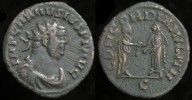
143 - Carausius - Antoninianus - RIC V Pt 2, 205Obv:- IMP CARAVSIVS P F AVG, Radiate draped and cuirassed bust right
Rev:- CONCORDIA MILITV,, Emperor and Concordia standing facing each other clasping hands
Minted in Camulodonum, //C
Reference:- RIC V Pt 2, 205
3/42 gms, 23.16 mm. 180 degreesmaridvnvm
|
|

171 - Magnentius - AE Centenionalis - RIC Amiens 005 Centenionalis
Obv:– D N MAGNEN-TIVS P F AVG, Bare-headed, draped & cuirassed bust right; A behind head
Rev:– VICTORIAE DD NN AVG ET CAE, two Victories standing facing each other, holding wreath inscribed VOT-V-MVLT-X
Mint – Amiens (//AMB).
Reference(s) – Cohen 70. Bastien 105 (3). RIC VIII Amiens 5 (S)
x.x gms, x.x mm. x degrees maridvnvm
|
|

205Carausius 287-93AD
Antoninianus
Obv “IMP CARAVSIVS PF AVG”
Radiate, draped and cuirassed bust right
Rev “CONCORDIA MILITV”
Emperor and Concordia standing facing each other clasping hands
Camulodunum mint
-/-//C
RIC 205mauseus
|
|
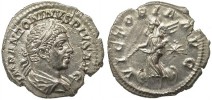
29 Elagabalus, 16 May 218 - 11 March 222 A.D.Silver denarius, BMCRE V 234, RIC IV 161, RSC III 300a, EF, 2.693g, 19.8mm, 180o, Rome mint, 220 - 222 A.D.; obverse IMP ANTONINVS PIVS AVG, laureate, draped and cuirassed bust right, from behind; reverse VICTORIA AVG, Victory flying left holding diadem in both hands, at each side a small shield, star right
Purchased from FORVMSosius
|
|

3 AurelianAURELIAN
AE Antoninianus, Rome Mint, Late 274 A.D.
IMP AVRELIANVS AVG, Bust right, radiate, cuirassed / ORIENS AVG, Sol stg. facing, head l., with r. hand raised and holding globe in l. hand; at feet, on each side, a bound and std. captive, both head turned back; the captive on the l. is in oriental dress, the captive on the r. is bearded and in Gallic costume. ∈XXIR in emerge.
RIC temp 1795: http://www.ric.mom.fr/en/coin/1795Sosius
|
|

305 - 306, SEVERUS II as Caesar, AE Follis struck 305 - 306 at Londinium (London), EnglandObverse: SEVERVS NOBILISSIMVS CAES. Laureate and cuirassed bust of Severus II facing right.
Reverse: GENIO POPVLI ROMANI. Genius, kalathos on head, standing facing left, holding patera in right hand and cornucopia in left; no mint-mark in exergue.
Diameter: 29mm | Weight: 10.399gms | Die Axis: 6h
RIC VI: 59a | Cohen VII: 24 | SPINK: 712
Rare
Ex. Errett Bishop Collection | Ex. FORVM (USA)
SEVERUS II
Flavius Valerius Severus Augustus was a Western Roman Emperor from 306 to 307. He was born in Northern Illyria (now Albania) and rose to become a senior officer in the Roman army. As an old friend of Galerius, that emperor appointed Severus as Caesar on 1 May 305 and he thus served as junior emperor under Constantius I in the Western Roman Empire.
When Constantius I died in the summer of 306, Severus was promoted to Augustus by Galerius under the rules of succession established under the Tetrarchy. However Constantius I had died on campaign in York and his army in Britain had acclaimed his son, Constantine I, as his successor. Although furious at this elevation, Galerius wanted to avoid any threat of a civil war so he compromised by allowing Constantine to bear the title of Caesar.
When this news reached Maxentius, the son of Maximianus, he revolted and declared himself emperor at Rome,
Galerius sent Severus, at the head of an army which had previously been commanded by Maximianus, to suppress the rebellion. Maxentius asked his father to re-assume the purple and rule the empire with him and Maximianus, who had been reluctant to abdicate, readily accepted. When Severus arrived under the walls of Rome to besiege it his men deserted to their old commander forcing Severus to flee to Ravenna. Maximianus offered to spare his life and treat him humanely if he surrendered peaceably. Severus complied but, despite Maximianus' assurance, he was displayed as a captive, imprisoned and later put to death.
*Alex
|
|

31 Maximinus I Thrax, 20 March 235 - Late May 238 A.D.Orichalcum sestertius, RIC IV 43, Cohen 10, VF, 23.158g, 32.3mm, 30o, Rome mint, 235 A.D.; obverse IMP MAXIMINVS PIVS AVG, laureate, draped and cuirassed bust right, from behind; reverse FIDES MILITVM S C, Fides standing half-left, military standard in each hand; well centered, nice patina, flan crack, typical squared flan
Purchased from FORVM Sosius
|
|
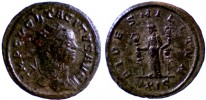
4 TacitusTACITUS
AR Antoninianus
IMP C M CL TACITVS AVG, radiate head right / FIDES MILITVM Fides standing, head right, holding standard in each hand, XXIS in ex.
RIC 87 (radiate head). F/aVFSosius
|
|

7 MaxentiusMaxentius. A.D. 306-312. Æ Follis (24.3 mm, 5.26 g, 11 h). Ostia, A.D. 309-312. IMP C MAXENTIVS P F AVG, laureate head right / AETERNITAS AVG, the Dioscuri standing facing each other, holding horses by their bridles; MOSTT in exergue. RIC 35. gVF.
Ex Agora Auctions #1, Nov 2013Sosius
|
|

7 MaxentiusMaxentius. A.D. 306-312. Æ Follis (24.5 mm, 5.69 g, 6 h). Ostia, A.D. 309-312. IMP C MAXENTIVS PF AVG, laureate head right / FIDES MILITVM AVG N, Fides standing left, holding standard in each hand: MOSTS in exergue. RIC 45. Good VF, brown patina.
Ex Agora Auctions - Nov 2013Sosius
|
|

843 - 855, IRREGULAR ISSUE, AE Styca, struck at York, EnglandObverse: + FGMVND (Wigmund) retrograde around group of five pellets in the form found on a dice. Cross pattée in legend.
Reverse: + EARDVVL retrograde around small cross with pellet in each of it's four angles. Cross pommée in legend. Moneyer: Eardwulf.
Diameter: 13mm | Weight: 1.16gms | Die Axis: Uncertain
SPINK: 872
This coin is an irregular issue which imitates an issue of Wigmund, who was Archbishop of York from around 837 to c.850, and the moneyer Eardwulf. Eardwulf was not a moneyer of regular coins for Wigmund so this coin is a bit of a concoction, something that is not uncommon with these irregular issues. Irregular stycas appear in a wide variety of types and a wide variety of imitative legends which are often blundered and sometimes completely unintelligible. The first appearance of the styca, a new style of small coin which replaced the earlier sceat, was at the beginning of the ninth century. Minted in York, several moneyers are named on the surviving coins, suggesting that they were struck in significant quantities. The written sources for late Northumbria are few, however the archaeological evidence from coinage is independent of the surviving annals and the evidence of Northumbrian coinage is particularly valuable when, in the ninth century, contemporary written evidence all but disappears.
These irregular issue coins were struck at a period of great instability in Northumbria. The last king to mint official stycas in any great quantity was Æthelred II who came to the throne around 841. Æthelred was assassinated around 848 and was succeeded by Osberht who was apparently killed in a battle with the Vikings around 867. The "Great Heathen Army" of Danish Vikings had marched on Northumbria in 866, they captured and sacked York towards the end of that year. Osberht was reputedly replaced as king by Ælla who is described in most sources as a tyrant, and not a rightful king, though one source states that he was Osberht's brother and fought and died alongside him. Evidence about Northumbrian royal chronology is unreliable prior to 867 and, though the beginning of Ælla's reign is traditionally dated to 862 or 863, his reign may not have begun until as late as 866. Ælla was apparently captured and killed by the Vikings, and after that the Vikings appointed one Ecgberht to rule Northumbria.
Official styca production ceased at some time during Osberht's reign although stycas remained in circulation until the Viking conquest of Northumbria in 867.
The Kingdom of Northumbria was a medieval Anglian kingdom in what is now Northern England and South-east Scotland. The name derives from the Old English Norþan-hymbre meaning "the people or province north of the Humber", Northumbria started to consolidate into one kingdom in the early seventh century when the two earlier territories of Deira and Bernicia united. At its height, the kingdom extended from the Humber Estuary in the south to the Firth of Forth (now in Scotland) in the north.
Northumbria ceased to be an independent kingdom in the mid-tenth century.*Alex
|
|

Alexius III AE Trachy S-2012
Alexius III AE Trachy S-2012 DOC 3
Beardless, nimbate bust of Christ, wearing tunic and kolobion; holds scroll in l. hand. Pellet s in each limb of nimbus cross.
REV Full length figure of Emperor on l. and of St. Constantine nimbate, holding between then Globus crucgier. Emperor and Saint wear stemma,divitision, collar piece and jeweled loros of simplified type; both hold labarum headed scepterBritanikus
|
|

Barbarous Imitation of Constantine era coin ,Danubian CeltsLaureate, helmeted, cuirassed bust right. Legend H H H H H H H T
Rev :H H H H H H H H H mint mark T? HII Two Victories standing, facing each other, together holding shield Britanikus
|
|

Byzantine Empire: Æ Anonymous Class I Follis, Attributed to Nicephorus III (Sear-1889, DOC I.1-64)Obv: Facing bust of Christ Pantokrator
Rev: Latin cross with central X and globus and two pellets at the end of each extremity; crescents to upper left and right, floral scroll below Quant.Geek
|
|

C. Vibius C.f. C.n. Pansa CaetronianusMoneyer issues of Imperatorial Rome. C. Vibius C.f. C.n. Pansa Caetronianus. 48 BC. AR Denarius (18mm, 3.73 g, 6h). Rome mint. Head of young Bacchus (or Liber) right, wearing ivy wreath / Ceres advancing right, holding a torch with each hand; plow to right. Crawford 449/2; CRI 21; Sydenham 946; Vibia 16. VF, toned, edge chip.
From the Archer M. Huntington Collection, ANS 1001.2.9.ecoli
|
|

Carinus, RIC V 251 RomeCarinus AE Antoninianus .
Obverse: IMP C M AVR CARINVS PF AVG, radiate, draped &cuirassed bust right.
Reverse: FIDES MILITVM, Fides standing left, flanked by a standard in each haand.
KAE in ex. Rome mint, 23 mm., 2.6 g.NORMAN K
|
|

CONCORDIA MILITVM, Thessalonica; RIC VIII 167Constantius Gallus, Caesar, AE Centenionalis. Thessalonica Mint, 23mm; FL IVL CONSTANTIVS NOB CAES, bare-headed & cuirassed bust right / CONCORDIA MILITVM, Gallus standing facing, head left, holding two labara, each bearing a Chi-Rho; G-//*TSE*. LRBC 1667. Thessalonica. RIC VIII 167.Podiceps
|
|
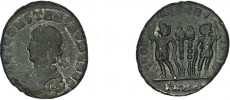
Constans, RIC VIII 141 HeracleaConstans, AE 3, 333-336 CE.
Obverse: FLI CONSTANS NOB CAES, laureate, draped, cuirassed bust left.
Reverse: GLORIA EXERCITVS, two soldiers facing each other holding spears and shields with two standards between them.
SMHE in ex. Heraclea mint, 17.7mm, 2.4 g.NORMAN K
|
|

Constans, RIC VIII 27 HeracleaRare left facing Constans as Augustus
Obverse: CONSTANS PF AVG, laurel and rosette diademed, draped & cuirassed bust left.
Reverse: GLORIA EXER CITVS, two soldiers standing facing each other and holding a spear in one hand and resting the other hand on shield withone standard between them.
SMHE in ex. Heraclea mint. 16.15 mm., 2.2 g.NORMAN K
|
|

Constans, RIC VIII 79 AquileiaObverse: CONSTAN-S PF AVG, laurel and rosette-diademed, draped, cuirassed bust right
Reverse: VICTORIAE DD AVGGQ NN, Two Victories facing each other with wreaths and palms
Mintmark: dot AQS, 15.5 mm., 1.1 g.
NORMAN K
|
|
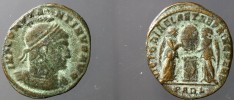
Constantine I, RIC VII 194 ArlesObverse: IMP CONSTAN-TINVS MAX AVG - Helmeted laureate bust right, cuirassed
Reverse: VICTORIAE LAETAE PRINC PERP - Two Victories facing and inscribing VOT PR on shield placed on altar type Helvetica 2d (diamond with dot in centre, in a rectangle with a dot in each corner. )
Exe: PARL Arles mint AD 318-319 = RIC VII, 194 , 19.15 mm, 2.6 g.NORMAN K
|
|

Constantine II, RIC VII 199 ThessalonicaConstantine II, AE follis, 18.6 mm, 1.8 g. Thessalonica.
Obverse: CONSTANTINVS IVN NOB C, laureate, draped & cuirassed bust right.
Reverse: GLOR-IA EXERCITVS, two soldiers standing, heads facing each other with two standards between them and each holds a spear and hand resting on a shield.
Mintmark SMTSB Thessalonica. 337-340 CE.
NORMAN K
|
|

Constantine II, RIC VII Siscia 236Constantine II, AE follis, 18mm, 1.8 g. Siscia.
Obverse: CONSTANTINVS IVN NOB C, laureate, draped & cuirassed bust right.
Reverse: GLOR-IA EXERCITVS, two soldiers standing, heads facing each other with two standards between them and each holds a spear and hand resting on a shield.
Mintmark dot ESIS dot, 334-335 CE issueNORMAN K
|
|

Constantius Gallus, Sirimun RIC 53Constantius Gallus AE3
Obverse: DN CONSTANTIVS IVN NOB C, bare-headed, draped, cuirassed bust right.
Reverse: FEL TEMP RE-PARATIO, soldier spearing fallen horseman who is bare-headed, bearded, reaching backwards.
Mintmark dot BSIRM dot, 18.4 mm, 2.2 g.NORMAN K
|
|

Constantius II, RIC 314 T, Rome.Obverse: DN CONSTAN-TIVS PF AVG, pearl diademed, draped, cuirassed bust right
Reverse: FEL TEMP-REPARATIO, soldier standing left, spearing fallen horseman who is bare headed , reaching backwards.
Mintmark: R dot M dot T
RIC VIII Rome 314, 18.9 mm., 2.2 g
NORMAN K
|
|

Constantius II, RIC VIII 102 Thessalonica, 347-348 CEObverse: CONSTANTIVS P F AVG, Laureate and Rosette-Diademed, draped, and cuirassed bust right
Reverse: VICTORIAE DD AVGG Q NN, two Victories standing facing each other, each holding wreath and palm.Palm branch upright in center.
Exe: SMTS epsilon. 16.6 mm., 1.0 g.
RIC VIII Thessalonica 102, rated scarce. NORMAN K
|
|

Constantius II, Siscia RIC VIII 369g, 324-361 CEConstantius II, AE 3 of Siscia
Obverse: DN CONSTAN-TIVS PF AVG, pearl diademed, draped, curiassed bust right.
Reverse: FEL TEMP-REPARATIO, soldier spearing fallen horseman who is wearing a Phrygian helmet, reaching backwards.
Mintmark gamma SIS reversed Z, Siscia, 19.08 mm, 2.1 g.NORMAN K
|
|

County of Tripoli, Raymond III (1152-87), Æ Pougeoise, (c.1173-1187) County of Tripoli, Raymond III (1152-87), Æ Pougeoise, (c.1173-1187), Tripoli mint +CIVITAS, towered gateway, rev., +TRIPOLIS, St. Andrew's cross pommettée, circle in centre, crescent in each quarter, (CCS 13)Vladislav D
|
|

County of Tripoli, Raymond III, 1152 - 1187 Bronze pougeoise County of Tripoli, Raymond III, 1152 - 1187 Bronze pougeoise
O : + CIVITAS fortified gateway, five rows of masonry, five crenellations, large divided door
R : + TRIPOLIS, St. Andrew's cross pommetée, circle in center, crescent and pellet in each quarter
CCS 13
Ex FORUM ; Ex MalloyVladislav D
|
|

Delmatius, Cyzicus RIC 132Obverse: FL IVL DELMATIVS NOB C, laureate, cuirassed bust right.
Reverse: GLORIA EXERCITVS, two helmeted soldiers facing each other, spear in outer hand, inner hand on shield setting on ground, between them a standard.
SMKD in ex. Cyzicus mint15.4 mm,1.8 g. Rated R3NORMAN K
|
|

Divus Constantine I, Posthumous commemorative AE4, 337-341 CEObverse: DN CONSTANTI-NVS PT AVGG, veiled head right.
Reverse: No legend, the deified Constantine driving quadriga right, hand of god reaching down from above, star at upper left.
SMANS in ex. Antioch mint, 2nd officina. RIV VIII 37, 16.6 mm, 1.4 g.
It is ironic that Constantine, who tradition tells us was the first Christian emperor (although he only actually became one on his death bed), should have been honored with pagan deification and commemorated posthumously with traditional pagan symbolism as found on this coin. He was the last emperor to be so honored.
NORMAN K
|
|

ENGLAND, NORMAN, Stephen (1135-1154), Silver Penny, Watford type .ENGLAND, NORMAN, Stephen (1135-1154), Silver Penny, Watford type .
Mint and moneyer uncertain . 1.0 gr
Crowned and diademed bust of king right, holding sceptre in his right hand .
Cross moline, with a fleur each angle .
North 873; SCBC 1278Vladislav D
|
|

Honorius RIC 403 CyzicusHonorius bronze AE4
Obverse: D N HONORIUS P F AVG, pearl diademed, draped and cuirassed bust right, star in left field.
Reverse: GLORIA ROMANORVM, Honorius and Theodosius II standing facing, heads confronted, each holding a spear vertically in outer hand and resting inner hand on shield. The emperor on the right is slightly smaller than the other.
SMK in ex. Cyzicus 15.24 mm, 2.0 g.NORMAN K
|
|
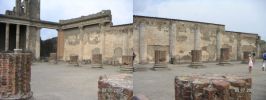
Italy- Pompeii- The BasilacaBASILICA
Forum of Pompeii c. 120 B.C. These more massive columns are from the basilica, the most important public building in Pompeii. Constructed prior to the Roman period, the basilica had three aisles and five entrance doors onto the forum. In the rear we see a two-tiered colonnade which has columns in the Doric style on the bottom and slender Ionic columns on top of a cross beam. In Pompeii many columns were made of brick and covered with stucco.
BASILICA (VIII,1,1)
Built in the second half of the 2nd cent. BC, as part of the plan to create monuments throughout the city. It has a rectangular layout, with three naves, with a ceiling sloping straight down in both directions from the central columns and half columns at the top of the walls, where there are still remains of decorations in ‘first style’: at the back is the tribunal, where the magistrates sat, reached by a wooden staircase. The building was dedicated to administering justice and for business negotiations.
Peter Wissing
|
|

Julian II RIC 370 Siscia, 355-360 CEObverse: DN IVLIANVS NOB CAES, bare-headed, draped and cuirassed bust right.
Reverse: FEL TEMP-REPARATIO, soldier standing left, spearing fallen horseman who is wearing Phrygian helmet, reaching backwards, M to left, DSIS-Zigzag in ex
RIC VIII Siscia 370, 16.9 mm., 2.2 g.NORMAN K
|
|

Julian II, RIC VIII 315 RomeJulian II, AE, Rome.
Obverse: DN CL IVL IVLIANVS NC, bare-headed, cuirassed bust right.
Reverse: FEL TEMP REPARATIO, soldier standing left, one kneeraised, spearing a fallen horseman who is looking left,reaching backwards, wearing Phrygian helmet.
Mintmark R dot M dot S. 16mm, 2.4 g.
NORMAN K
|
|

Louis XIV and Marie-Thérèse, AE (Brass) Jeton struck c.1667Obverse: +LVD•XIIII•ET•MAR•THER•D•G•FRA•ET•NAV•REX•ET•REG. Busts of Louis XIV and Marie Therese facing one another. To the left, draped and laureate bust of Louis XVI facing right. To the right, draped bust of Marie Therese facing left, small crown on the back of her head.
Reverse: VINCIT•DVM•RESPICIT (The sun dissipates the clouds). Radiant disc of the sun with facial features parting billowing clouds below; in exergue, 1667.
Dimensions: 27mm | Weight: 6.1gms | Die Axis: 6
Ref. Feuardent: 13069
Struck at Lisse, Netherlands
Die engraver: Unknown
Marie-Thérèse, daughter of Philip IV of Spain, was born on the 10th of September 1638. She was also called Marie-Thérèse D'Autriche because the Spanish Kings of those days had a Hapsburg-Austrian origin and her name refers to that and not the home country were she was born and lived.
In 1660 Philip IV, and the entire Spanish court accompanied Marie-Thérèse to the Isle of Pheasants, in the Bidassoa, where she was met by Louis XIV and his court. She and Louis XIV were married in 1660, the marriage agreement being one aspect of the peace negotiations that took place between Spain and France during 1659 and 1660. On the day of her wedding, Marie-Thérèse wore a gown covered in the royal fleur-de-lys and it is said that her uncovered hair proved to be so thick that it was difficult to attach a crown to it. This might account for the odd positioning of the crown as it appears on her bust.
Jetons commemorating the marriage, bearing the busts of Louis XIV and Marie-Thérèse, were issued each year from 1660 through to 1673. Marie-Thérèse died on 30th July, 1683.*Alex
|
|

P. Clodius M.f. TurrinusMoneyer issues of Imperatorial Rome. P. Clodius M.f. Turrinus. 42 BC. AR Denarius (19mm, 3.89 g, 1h). Rome mint. Laureate head of Apollo right; lyre behind / Diana Lucifera standing right, bow and quiver on her shoulder, holding torch in each hand. Crawford 494/23; CRI 184; Sydenham 1117; Claudia 15. Good VF, toned, a few minor scratches beneath the toning.
From the RAJ Collection. Ex CNG Inventory 914993 (2012 NYINC); Sincona 4 (25 October 2011), lots 4160 or 4161 (part of), includes ticket from a French Collectio
ecoli
|
|

Phoenicia, Akko-Ptolemais Valerian I. 253-260 AD. AE 26Valerian I. 253-260 AD. AE 26 . Phoenicia, Akko-Ptolemais.
Obv: IMP C P L - [VALERIANVS] AVG Laureate, draped, cuirassed bust right, seen from front.
Rx: COL - P - T - OL Sacred tree between serpents rising from two altars or baskets; to right, winged caduceus. Rare: this type missing in BM, Lindgren, Berk photofile, and Wildwinds. CoinArchives includes a specimen from the same reverse die, but with radiate portrait on obverse: Heritage 357, Long Beach, 9 September 2004, lot 12092. Cohen 374 (de Saulcy Collection). Adjustment marks on obverse.
Maritima
|
|

SOLD Antiochus 1 Soter 281-261 BC Posthumous Tetradrachm SOLD SOLD Obverse: Diademed head of Antiochus 1 facing right
Reverse: Apollo sitting on ompholos testing arrow in RH, LH holding grounded bow.
2 monograms, one in each field
Ins- ΒΑΣΙΛΕΩΣ ΑΝΤΙΟΧΟΥ
A posthumous coinage from the reign of Antiochus 11
Mint of Seleucia on the Tigris
SC 587.1c 17g 29.5mm SOLDcicerokid
|
|

Г (incised)PISIDIA. Ariassus. Julia Mamaea. Æ 25. A.D. 222-235. Obv: IOVΛIAMA-MEAC(EB...). Diademed and draped bust right; Incises countermark before. Rev: (A)PIACC(EΩN). Dioscuri standing naked, each infront of a horse, holding a spear; above star in crescent. Ref: BMC -; SNG France (3) -; SNG Aul -. Axis: 195°. Weight: 9.29 g. CM: Г (incised), incuse, 4 x 6 mm. Howgego 778 (11 pcs). Collection Automan.Automan
|
|

ROME
PB Tessera (20mm, 5.35 g, 12h)
Draped bust of Hercules left, wearing lion's skin and holding club over shoulder, with hair and beard in Antonine-Severan style
The Dioscuri standing facing one another, each holding spear and bridle of horse
Rostovtsev 2085; Rostovtsev & Prou 377
Rostovtsev suggests that the obverse may depict Caracalla. This interpretation is somewhat plausible, but unlikely, considering the additional object on the obverse, and the bare head of the figure.Ardatirion
|
|

UNITED STATES, Native proto-currency. Seneca tribe.
Ganounata village (Honeoye Falls, NY). Circa AD 1625-1687
White wampum beads (apx. 5mm, 0.10g each)
Carved white shell beads with lateral hole for suspension in belt
Cf. William Martin Beauchamp, Wampum and Shell Articles Used by the New York Indians, p. 369
Found at the Dann Farm site in Honeoye Falls, NY.
In 1687 combined French and Huron forces, lead by the Marquis de Denonville, set out to undermine the strength of the Iriquois Confederacy. The main strike was made against Seneca villages in Western New York. Ganounata was burned during the campaign. This episode was only one in a long line of conflicts fought over control of the North American fur trade.
Wampum was used by Native Americans in woven belts of white and black beads. The white beads were crafted from the columella of the Channeled Whelk, the black from the quahog. Traditionally, wampum belts were used as a ceremonial object to initiate a trade contract. It was only with the coming of the Europeans that wampum began to function as coinage. In 1673, New York state officially set the value of wampum at six white beads to the Dutch stuiver, or three black until they fell out of use. Ardatirion
|
|

D.175 Charles the Great [Charlemagne] (denier, class 3, Bourges)Charles the Great, king of the Franks (768-840) and Holy Roman emperor (800-814)
Denier (Bourges, class 3, 781-800)
Silver, 1.18 g, 20 mm diameter, die axis 3h
O/ [+CA]RLVS REX FR; cross pattée with a crescent in each quarter
R/ [+B]ITVRICA[S]; carolingian monogram KRLS
For the 3rd type of his coinage, Charles the Great introduced the famous KRLS monogram. This one contains all the letters of Karolvs : the consonants are clearly written at the edges and bound by a lozenge. The vowels are at the center of the monogram: A (using the upper part of the lozenge, O as the whole lozenge and V as the down part of the lozenge).
This monogram still appeared two centuries later in the coinage of Hugh Capet, first capetian king.
|
|

D.762 Charles II the Bald (denier, class 1e, Paris)Charles the Bald, king of the Franks (840-877)
"Temple" denier (Paris, class 1e, 840-864)
Silver, 1.70 g, 20 mm diameter, die axis 4h
O/ +CΛRLVS REX FR; cross pattée
R/ +PΛRISII CIVITΛS; temple
The mint's name (Paris) stands in for the usual legend XPISTIANA RELIGIO. The royal authority may have been quite weak in the beginning of Charles' reign, and each mint may have been tempted to make a clear legend to characterize its own coinage.
|
|

Dy.102 Louis VI (the Fat): denier (Étampes)Louis VI the Fat, king of the Franks (1108-1137)
Denier (Étampes, 3rd emission)
Billon, 1.13 g, diameter 19 mm, die axis 2h
A/ +LODOVICVS REX I; large E with a ringlet on the left, and 4 pellets on top of each other and a X on the right
R/ STΛMPIS CΛSTELLVM ; cross pattée with 2 Λ
|
|

Dy.230B Philip IV (the Fair): simple tournoisPhilip IV, king of France (1285-1314)
Simple tournois (1295-1303)
Billon (399 ‰), 0.83 g, diameter 14-15 mm, die axis 6h
O: cross pattée with a symbol in each quadrant : P, h, I and a cross
R: chatel tournois' pediment with 2 fleur-de-lis
|
|

Saint Martial abbey: denier (Limoges)Saint Martial abbey, Limoges, anonymous (1100-1150)
Silver, 1.14 g, diameter 18 mm, die axis 3h
O/ +SES•MARCIAL; facing bearded bust of Saint Martial
R/ +LEMOVICENSIS; beaded cross with 2 pellets in each quadrant
|
|

"C" denarius, RRC 107/1b (var)Denomination: Denarius
Era: C. 209-208 BC
Metal: AR
Obverse: Helmeted head of Roma R,; X behind. Border of dots
Reverse: Dioscuri on horseback right, each holding spear, star above each head; "C" above; ROMA in 3-line frame.
Mint: Uncertain (Etruria?)
Weight: 4.36 g
Reference: RRC 107/1b (var)*
Provenance: NAC 125, Lot 372
Ex De Nicola Fixed price list June 1967, 229.
*This variety is not seen in the RRC plates, but it is depicted and differentiated in Grueber. (See Grueber II p. 188, #186, Plate LXXXIV 8.). Style only seen on 107 ("C"), not on 106 (staff). Crawford doesn't speculate on the meaning of the "C", or whether it is a mintmark or a moneyer's symbol. Sydenham notes that the bronze coins with C are sometimes overstruck on Sardinian coins, suggesting a mint in Sardinia. Grueber speculates that the C is a minmark for Canusium.
|
|

"D" Denarius, RRC 171/1Denomination: Denarius
Era: C. 199-170 BC
Metal: AR
Obverse: Helmeted head of Roma R,; X behind. Border of dots
Reverse: Dioscuri on horseback right, each holding spear, star above each head; "D" below; ROMA in 2 line frame.
Mint: Uncertain
Weight: 4.75 g
Reference: RRC 171/1
Provenance: Soler y Llach, Auction May 6, 2021, lot 260
Quite scarce in higher grades. Exceptional style for the issue. Lovely light toning possibly the finest known and EF.
|
|

"Sow" series denarius, RRC 121/2Denomination: Denarius
Era: C. 209-195 BC
Metal: AR
Obverse: Helmeted head of Roma R,; X behind. Border of dots
Reverse: Dioscuri on horseback right, each holding spear, star above each head; "Sow" below; ROMA in 3line frame.
Mint: Rome (?)
Weight: 3.36 g
Reference: RRC 121/2
Provenance: NAC 125, Lot 376, June 24, 2021
Ex Sternberg XXI, 1988, 241 and NAC 73, 2013, Student and his Mentor part II, 38 sales.
Very rare. Reverse slightly off-centre, otherwise good extremely fine with lovely reflective surfaces.
Trace of undertype on both obverse and reverse. Note the 2nd border on the lower edge (beaded), and the raised area in front of Roma's obverse face (extended tail of early denarius?), also some hint of undertype below truncation.
|
|

(0161) MARCUS AURELIUS161 - 180 AD
Struck 161 - 162 AD
AE Dupondius, 25 mm 10.87 g
O: IMP CAES M AVREL ANTONINVS AVG P M, Radiate head right.
R: CONCORD AVGVSTOR TR P XVI COS III, Aurelius and Verus facing each other, clasping hands.
Ref: RIC 828
laney
|
|

(0161) MARCUS AURELIUS 161 - 180 AD
Struck 161 - 162 AD
AE Dupondius, 25 mm 9.90 g
O: Radiate of M. Aurelius head right.
R: CONCORD AVGVSTOR TR P XVI COS III, Aurelius and Verus facing each other, clasping hands.
cf: RIC 828laney
|
|
| 4815 files on 54 page(s) |
1 |
 |
 |
 |
 |
|

|
